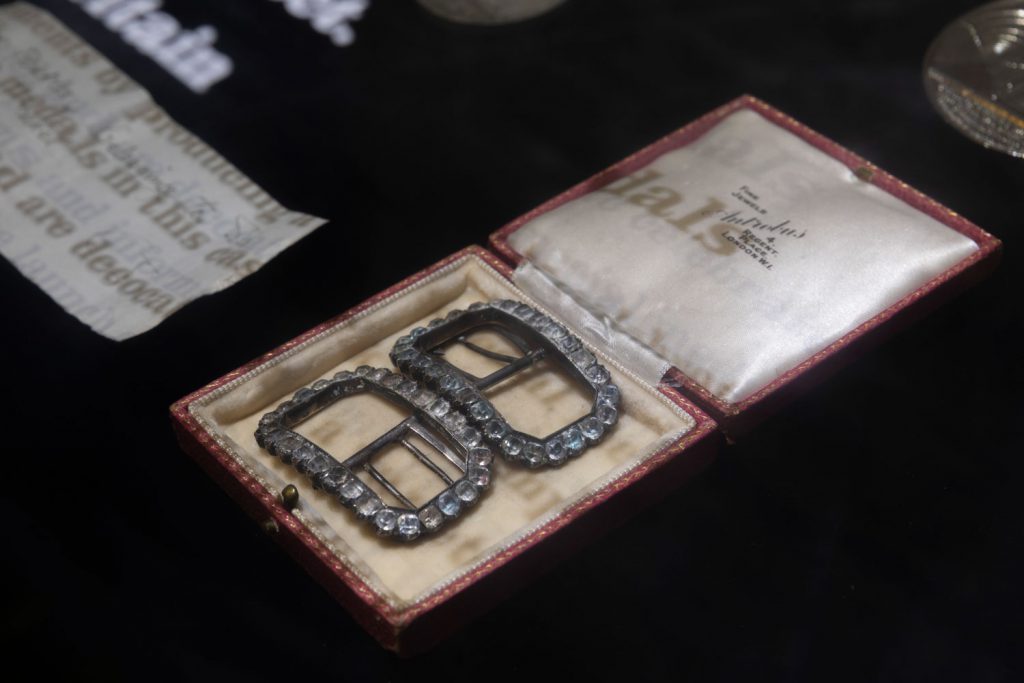Given their shape, size and material composition, these buckles likely date from the last quarter of the eighteenth century. They carry no hallmarks or makers’ marks. It is unclear where the buckles were made, though the most likely place is Britain, from where many buckles of this type were exported elsewhere. Since buckles and shoes were sold separately in this period, to be swapped and changed as needed or desired, we do not know with what shoes Brunel paired these buckles.
When Marc Brunel was born in 1769, buckles of this kind were extremely popular, worn by wealthy gentleman in an array of sizes, shapes, and styles. By Brunel’s death in 1849, such buckles were essentially unheard of. Several factors led to their demise, including revolutions, taxes, and the requirements of a new mercantile bourgeoisie with more mobile lifestyles. This apparently did not induce Brunel to give up his buckles. Charles MacFarlane, friend of I.K. Brunel, met Marc Brunel for the first time in 1829. In his later account of their meeting, MacFarlane remarked that Brunel wore the ‘dress of a French gentleman of the ancien régime, for he had kept to a rather antiquated, but very becoming, costume’. Men’s clothing was in this period undergoing a radical series of changes, becoming less colourful and more austere, with breeches replaced by trousers as well as buckles by laces. MacFarlane’s comment suggests Brunel resisted these changes.
Why would Brunel have continued to wear ‘antiquated’ buckles? The clue is in MacFarlane’s reference to Brunel’s as ‘a French gentleman of the ancien régime’. In the eighteenth century, silver buckles decorated with paste gemstones (on which a specific tax was levied) were beyond the reach of most individuals. Wearing such items thus publicly demonstrated an aristocratic socio-economic position. Brunel, however, was not a ‘gentleman’ by birth. The foreign-born son of a French farmer, Brunel had to work hard to form his public image in Britain. One way to do this was to dress the part.
Another reason Brunel may have kept these buckles after they ceased to be fashionable is that, from a French perspective, shoe buckles had become highly politicised in the context of the French Revolution of 1789. In September 1789, a letter was read to the revolutionary National Assembly in which a soldier offered the nation his silver shoe buckles and declared he would only wear army-issued copper buckles instead, urging others to follow his example. Two months later, the entire Assembly agreed to give up their silver shoe buckles. Registers of ‘patriotic gifts’ confirm vast quantities of shoe buckles were presented to the State, and buckles thus took on a profound significance in the new revolutionary order. The National Dictionary (1790) of fervent revolutionary Pierre-Nicolas Chantreau defined ‘buckle’ as a ‘superfluous ornament, which denotes an aristocrat or a cold-hearted egotist’. Chantreau suggests revolutionaries instead wear ‘national buckles, made of copper, a lowly metal, but one which honours the patriotic foot which wears it’. Examples of such ‘national buckles’ survive.
Buckles were so closely associated with the Revolution that an anti-revolutionary pamphlet was entitled Give me back my buckles!; the pro-revolutionary response was subtitled We’ll give you back your buckles. One commentator noted that ‘one no longer dares leave the house with silver buckles; the populace nowadays insults those who wear them; one is obliged to wear copper buckles, or else to fasten ones shoes with simple ribbons’. This negotiation of political ideology via clothing must be seen as part of a wider ‘sartorial revolution’, in which revolutionaries wore specific garments – cockade pins, bonnet rouge hats, carmagnoles jackets – to publicly identify their politics. In fact, so fundamental was clothing to the revolutionaries’ public image that they acquired the collective moniker les sans-culottes (‘the people-without-breeches’), a reference to their preferred style of dress.
Brunel’s opposition towards the French Revolution appears clear. His colleague on the Tunnel, Richard Beamish, relates that in January 1793, Brunel was in a Paris café when he loudly made an ill-judged comment during a row with an ‘ultra-republican’. Brunel, Beamish writes, only narrowly escaped, travelling to Rouen, often considered a centre for anti-revolutionary politics. King Louis XVI was executed on 21 January 1793 and, a few months later on 7 July, Brunel fled France for the United States. In this context, wearing the buckles identified Brunel as part of the ‘old guard’. Even simply retaining them could be an act of resistance compared to donating them to the revolutionary government.

